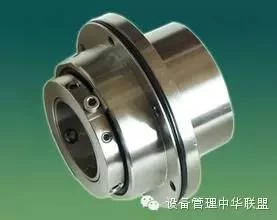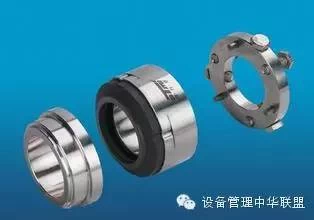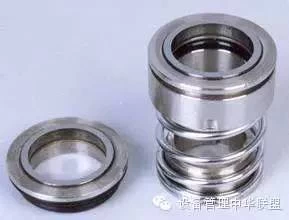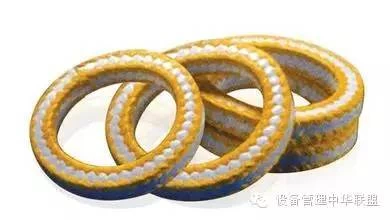Mechanical seal knowledge
Mechanical seals are one of the basic mechanical components with precision and complex structure, and are the key components of various pumps, reaction synthesis kettles, turbo compressors, submersible motors and other equipment. Its sealing performance and service life depend on many factors, such as model selection, machine accuracy, correct installation and use, etc.
Basic knowledge of mechanical seals
1. The basic concept of mechanical seal:
Mechanical seal refers to a device that prevents fluid leakage by keeping at least a pair of end faces perpendicular to the rotation axis under the action of fluid pressure and elastic force (or magnetic force) of the compensation mechanism and the cooperation of auxiliary seals to keep fit and slide relatively. The auxiliary seal of the compensation ring is a metal bellows called a bellows mechanical seal.
2. The composition of the mechanical seal:
There are mainly the following four types of components. a. Main seals: moving ring and static ring. b. Auxiliary seal: sealing ring. c. Pressing parts: spring, push ring. d. Transmission parts: elastic pan seat and key or fixing screw

should pay attention to the problem
1. Precautions during installation
a. Pay great attention to avoid installation deviations during installation
(1) Tightening the gland should be carried out after the coupling is aligned, and the bolts should be evenly supported to prevent the end face of the gland from being skewed. Check each point with a feeler gauge, and the error is not greater than 0.05 mm.
(2) Check the matching clearance (ie concentricity) between the gland and the outer diameter of the shaft or bushing.
b. The amount of spring compression should be carried out according to the regulations, and it is not allowed to be too large or too small, and the error is required to be 2.00 mm. If it is too large, the specific pressure of the end face will increase, and the end face will be worn at another speed. If it is too small, the specific pressure will be insufficient and the sealing effect cannot be achieved.
c. After the moving ring is installed, the beard is guaranteed to be able to move flexibly on the shaft, and it should be able to bounce back automatically after the moving ring is pressed against the spring.
2. Precautions when disassembling
a. Be careful when disassembling the mechanical seal, and it is strictly forbidden to use a hand hammer and a flat shovel to avoid damage to the sealing element. A pair of wire hooks can be made, and the sealing device can be pulled out by extending into the gap of the transmission seat in the direction of self-financing. If the scale cannot be removed, it should be cleaned and then removed.
b. If mechanical seals are used at both ends of the pump, take care of each other during assembly and disassembly to prevent one from neglecting the other.
c. For the mechanical seal that has been operated, if the gland is loose and the seal moves, the dynamic and static ring parts must be replaced, and should not be re-tightened to continue use. Because the original running track of the friction pair will change after the same movement, the sealing performance of the contact surface is easily damaged.
Mechanical seal normal operation and maintenance
1. Preparations and precautions before starting
a. Comprehensively check whether the mechanical seal, as well as the installation of auxiliary devices and pipelines are complete, and whether they meet the technical requirements.
b. Before starting the mechanical seal, perform a static pressure test to check whether there is leakage of the mechanical seal. If there are too many leaks, the cause should be found out and tried to eliminate. If it is still invalid, it should be disassembled, checked and re-installed. The general static pressure test pressure is 2~3 kg/cm².
c. Press the pump to turn the steering wheel to check whether it is light and even. If the cranking is difficult or does not move, check whether the assembly size is wrong and whether the installation is reasonable.
2. Installation and shutdown
a. The sealed cavity should be kept filled with liquid before starting. When conveying solidified media, the sealed cavity should be heated with steam to melt the media. The crank must be cranked before starting to prevent the soft ring from breaking due to sudden start.
b. For the mechanical seal using the oil sealing system outside the pump, the oil sealing system should be started first. Finally stop the oil sealing system after parking.
c. After the hot oil pump is out of operation, the cooling water in the sealing oil cavity and the end face seal cannot be stopped immediately. The cooling water can only be stopped when the oil temperature at the end face seal drops below 80 degrees, so as to avoid damage to the sealing parts.
3. Operation
a. If there is slight leakage after the pump is started, observe it for a period of time. If the leakage is still not reduced after continuous operation for 4 hours, the pump should be stopped for inspection.
b. The operating pressure of the pump should be stable, and the pressure fluctuation should not be greater than 1 kg/cm2.
c. During the operation of the pump, the phenomenon of evacuation should be avoided to avoid dry friction of the sealing surface and seal damage.
d. The sealing condition should be checked frequently. During operation, when the leakage exceeds the standard, the heavy oil is not more than 5 drops/min, and the light oil is not more than 10/min. If there is no improvement trend within 2-3 days, the pump should be stopped to check the sealing device.
The development of "sealing" has a long history in my country. The ancients used cotton, hemp and other fibers to make water-lifting machinery seals, while foreign countries did not use packing until 1782. The importance of sealing will not be discussed here. The discipline that studies the laws of sealing, the design technology of sealing devices, and the principles of applied science—“sealing” has emerged, and scientific research institutions also have specialized courses on sealing. In my country, so far, as far as I know, there are fluids in universities. There are courses such as mechanics and hydraulic transmission, but there is no "sealing system" specializing in sealing, so our research level is still far behind that of foreign countries.
There are many professional fields of seal design, in addition to materials and mechanics, there are mechanics (including fluid mechanics, boundary layer theory, etc.), tribology, automatic control and so on. Therefore, in terms of sealing, the research difficulty is relatively large. The level of the domestic sealing industry, I personally think that the gap compared with foreign countries should be no less than 50 years.

About the sealing principle
If you want to learn sealing, you must first understand leakage. If you understand the principle of leakage, you will have the corresponding sealing mechanism. There are three types of leaks -
One is leakage, that is, the leakage between the sealing surface gaps
The second is leakage, which is the leakage of the sealed fluid through the capillary of the seal material
The third is diffusion, which refers to the material transfer of the sealing medium through the gap or the capillary of the material under the action of the concentration difference.

About the sealing method
There are roughly the following methods of sealing:
1. Minimize the number of sealing parts 2. Blocking and isolation 3. Lead out or inject 4. Increase leakage resistance 5. Add working elements in the channel 6. Combination of various sealing methods

Common Seal Forms
Gasket seals, packing seals, mechanical seals, non-contact seals, and fluid-injection plugging under pressure are common forms of sealing. Among them, the packing seal should be the most common, and it also includes soft packing, hard packing and forming packing. Formed packing seals include our common O-rings, Y-rings, oil seals, and more. Non-contacting seals include gap seals, labyrinth seals, floating seals, dynamic seals, magnetic fluid seals and hermetic seals.

Common gasket properties---and new materials and technologies
1) Common gasket performance
When using the valve, the original gasket is often replaced according to the specific situation. Common gaskets are: rubber flat gasket, rubber O-ring, plastic flat gasket, PTFE-covered gasket, asbestos rubber gasket, metal flat gasket, metal special-shaped gasket, metal sheathed gasket, wave gasket, wound gasket, etc.
(1) Rubber flat washers: easy to deform and easy to press, but poor pressure and temperature resistance, only used in places with low pressure and low temperature. Natural rubber has a certain acid and alkali resistance, and the operating temperature should not exceed 60 °C; neoprene rubber is also resistant to some acids and alkalis, and the operating temperature is 80 °C; nitrile rubber is oil-resistant and can be used up to 80 °C; Fluorine rubber has good corrosion resistance and is resistant to The temperature performance is also stronger than that of general rubber, and it can be used in a medium of 150 °C.
(2) Rubber O-shaped washer: The cross-sectional shape is a perfect circle, and it has a certain self-tightening effect. The sealing effect is better than that of the flat washer, and the pressing force is smaller.
(3) Plastic flat washer: The biggest feature of plastic is good corrosion resistance, and most plastics have poor temperature resistance. PTFE is the crown of plastics. It not only has excellent corrosion resistance, but also has a wide temperature resistance range. It can be used for a long time within -180℃~+200℃.
(4) PTFE-wrapped gasket: In order to give full play to the advantages of PTFE and at the same time make up for its poor elasticity, a PTFE-wrapped rubber or asbestos rubber gasket is made. In this way, it is not only as corrosion-resistant as the PTFE flat gasket, but also has good elasticity, enhancing the sealing effect and reducing the pressing force. Its cross-sectional shape is shown in Figure 4-20.
(5) Winding washer: It is a thin metal belt and a non-metallic belt that are closely attached together and wound into a multi-layer circle with a wavy cross-section, which has good elasticity and sealing. Metal strips can be made of 08 steel, 0Cr13, 1Cr13, 2Cr13, 1Cr18Ni9Ti, copper, aluminum, titanium, Monel, etc. Non-metallic belt materials include graphite, polytetrafluoroethylene, etc.
Asbestos rubber sheets are available in four colors:
Gray, for low pressure (grade XB-200, pressure resistance ≤ 16 kg/square centimeter, temperature resistance 200 ℃);
Red, for medium pressure (brand XB-350, pressure resistance up to 40 kg/cm 2 , temperature resistance 350 ℃);
Purple, used for high pressure (brand XB-450, pressure resistance 100 kg/square centimeter and temperature resistance 450 ℃);
Green, used for oil, pressure resistance is also very good.
(6) Metal flat heating ring: lead, temperature resistance 100℃; aluminum 430℃; copper 315℃; low carbon steel 550℃; silver 650℃; nickel 810℃; Monel (nickel-copper) alloy 810℃, stainless steel 870℃ . Among them, lead has poor pressure resistance, aluminum can withstand 64 kg/square centimeter, and other materials can withstand high pressure.
(7) Metal heterosexual gasket:
Lens Gasket: Self-tightening, used for high pressure valves.
Oval washers: also belong to high pressure self-tightening washers. Conical double gasket: used for high pressure internal self-tightening seal.
In addition, there are square, diamond, triangle, tooth, dovetail, B, C, etc., which are generally only used in high and medium pressure valves.
(8) Metal sheathed gasket: Metal has both good temperature and pressure resistance and good elasticity. Foreskin materials include aluminum, copper, low carbon steel, stainless steel, Monel alloy, etc. The filling materials are asbestos, PTFE, glass fiber and so on.
(9) Wave washer: It has the characteristics of small pressing force and good sealing effect. Often in the form of a combination of metals and non-metals.
Above, when describing the performance of sealing gaskets, some figures are listed. It must be noted that these numbers are closely related to the flange form, medium conditions and installation and repair techniques, and sometimes can be exceeded, sometimes not achieved, and the pressure and temperature resistance performance is also mutually transformed, such as the temperature is high, resistance The pressure capacity is often reduced, and these subtle problems can only be experienced in practice.
2) New materials and technologies
The gaskets described above are far from comprehensive, and sealing technology is developing rapidly. The following examples introduce several new materials and technologies.
(1) Liquid sealing: With the rapid development of polymer organic synthesis industry, liquid sealant has appeared, which is used for static sealing; this new technology is usually called liquid sealing. The principle of liquid sealing is to use the adhesiveness, fluidity and monomolecular film effect of liquid sealant (the thinner the film, the greater the natural recovery tendency), under appropriate pressure, it can act like a gasket. Therefore, the sealant used is also called a liquid gasket.
(2) PTFE raw material sealing: PTFE is also a polymer organic compound. Before it is sintered into a product, it is called a raw material, with a soft texture and a monomolecular film effect. The belt made of raw material is called raw material belt, which can be rolled into a coil for long-term storage. When used, it can be freely formed, and any joint, as long as there is pressure, will form an annular membrane that evenly plays a sealing role. As a gasket between the valve body and the valve cover in the valve, it can be pryed open a gap and stuffed into the raw material without taking out the valve disc or gate. The pressing force is small, it does not stick to the hand or the flange surface, and the replacement is very convenient. Best suited for tongue and groove flanges. PTFE raw material can also be made into tube and rod shape for sealing.
(3) Metal hollow O-ring: good elasticity, small pressing force, and self-tightening effect, a variety of metal materials can be selected, so that it can be adapted to low temperature, high temperature and strong corrosive medium.
(4) Graphite plate sealing ring: In people's impression, graphite is a brittle substance, lacking elasticity and toughness, but the specially treated graphite is soft in texture and good in elasticity. In this way, the heat resistance and chemical stability of graphite can be displayed in the gasket material; and the gasket has a small pressing force and excellent sealing effect. This graphite can also be made into belts, which can be combined with metal belts to form wound washers with excellent performance. The appearance of graphite plate sealing ring and graphite-metal wound gasket is a major breakthrough in high-temperature corrosion-resistant sealing. Such gaskets have been produced and used in large quantities abroad. Graphite packing normally used for high temperature check valve
 +86 512 68781993
+86 512 68781993 


















